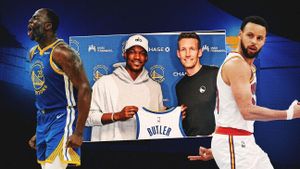Kendrick Lamar made history with his Super Bowl 2025 halftime show, setting the record for the most-viewed performance during the event with 133 million viewers tuning in to see the rapper deliver both artistry and critique of American culture.
The performance, held at the Caesars Superdome in New Orleans on February 9, 2025, was not just another memorable halftime show; it was an intense, thought-provoking experience where Lamar seamlessly blended music, visuals, and commentary on social issues. Joining him on stage were notable figures including SZA and Samuel L. Jackson, who served as the emcee dressed as Uncle Sam, presenting the performance with his signature blend of humor and gravity.
Lamar's setlist featured ten songs, predominantly from his controversial and recently released album, GNX, alongside his diss track aimed at fellow artist Drake, titled “Not Like Us.” Though he omitted the explicit label of “pedophile” from his performance, his references were pointed and unmissable, adding layers of tension and rivalry to the spectacle. His decision to focus on new material rather than greatest hits challenged conventional expectations of Super Bowl halftime shows.
The visual elements of the performance were equally significant. The dancers wore costumes symbolically colored red, white, and blue, forming shapes of the American flag at times. This not only represented national pride but called attention to cultural divisions as Lamar subtly referenced the Bloods and the Crips. Through this duality, his show garnered applause for addressing complex themes of unity and strife inherent within American society.
While the atmosphere radiated pride and celebration, critics and fans alike were quick to dissect the performance's underlying messages. Many viewers noted how Lamar's performance diverged from more traditional halftime shows, which often focus on nostalgia. This departure sparked fervent discussions online, with some praising him for his authentic approach, saying, “Kendrick Lamar is literally the only thing bringing me any hope or joy rn,” as shared on social media.
Conversely, not everyone embraced the provocative nature of his show. Conservative commentators criticized Lamar’s message, such as Colin Rugg, who remarked, “Kendrick Lamar says 'turn this TV off' before ending his Super Bowl halftime performance.” This sparked counter-reactions and added fuel to the divisive discourse surrounding his appearance.
The NFL's decision to feature Lamar, known for his outspoken views on race and inequality, at such a significant event underscored the shifting narrative surrounding America’s most watched game. With the Philadelphia Eagles clinching their second Super Bowl title, the Chiefs succumbed to defeat, but it was Lamar's performance echoing long after the final score, dominating headlines for days thereafter. Viewer statistics reflected this, as the game itself reached unprecedented numbers with 127.7 million viewers overall, marking it the most-watched Super Bowl to date.
Leading up to the event, many anticipated how Lamar would capitalize on his recent Grammy wins, where he snagged five awards, including Record of the Year for “Not Like Us.” The starkly choreographed dynamics of his halftime show were highlighted by the guest appearances, including SZA, who collaborated on songs like “All the Stars” and “Luther,” and tennis superstar Serena Williams, whose presence prompted speculation due to her past with Drake. Williams' performance was not merely symbolic; it reinforced Lamar's thematic exploration of cultural connections amid rivalry.
Following the show, social media exploded with clips of the performance, quickly amassing millions of views on platforms like YouTube, allowing fans to relive the groundbreaking event. Music commentator Chart Data declared Lamar as the new record-holder for monthly Spotify listeners among hip-hop artists, surpassing Drake, perhaps signaling the cultural ramifications of his bold statements during the show.
With the phenomenon of the halftime show cemented as one not just for entertainment but for cultural discourse, Kendrick Lamar managed to engage and provoke millions. His tenure at the Super Bowl indicates not just where entertainment stands, but how artists can reflect societal tensions on monumental stages. The NFL gained record ratings, but more significantly, they opened the door for conversations around race, artistry, and activism on one of the biggest platforms available.
Whether heralded as genius or criticized for its brashness, Kendrick Lamar's Super Bowl halftime show left indelible marks on American culture, pushing the boundaries of what such performances can mean and who they can speak to.



